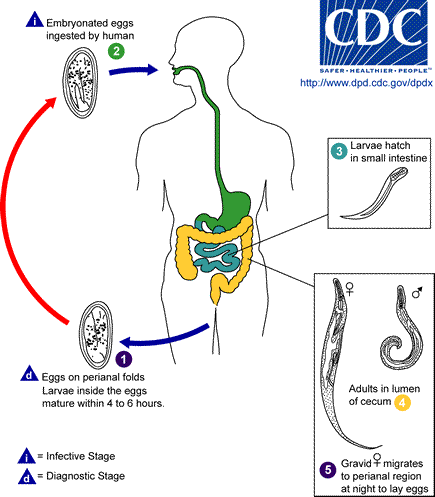Enterobiasis pathophysiology
|
Enterobiasis Microchapters |
|
Diagnosis |
|---|
|
Treatment |
|
Case Studies |
|
Enterobiasis pathophysiology On the Web |
|
American Roentgen Ray Society Images of Enterobiasis pathophysiology |
|
Risk calculators and risk factors for Enterobiasis pathophysiology |
Editor-In-Chief: C. Michael Gibson, M.S., M.D. [1]
Pathophysiology
Pathogenesis
- It is postulated that Enterobius vermicularis triggers an inflammatory response which is associated with the low-grade eosinophilia. Allergic response to the worm protein can result in pruritus; usually pruritus ani (perianal pruritus).
- The infective eggs of E. vermicularis are ingested via contaminated hands or fomites(clothing, toys, bed, furniture, animals' fur etc). The eggs mature into adult Enterobius in 15-40 days. Male adult larvae fertilize the female (in lower ileum) and are passed out in stools without producing symptoms. Adult females settle in the lower ileum, caecum, appendix and ascending colon. The gravid worm migrates from the colon to the rectal area. At night eggs laid on the perianal skin by the uterine contraction(s) of the gravid worm.
- At oviposition, the eggs are immature and non-infective. They become infective within 6 hours at body temperature. In cool, moist environment with little ventilation eggs remain viable for up to three weeks. However, the infectivity decreases with time. Eggs do not tolerate heat that well which might be the reason that enterobiasis is more common in temperate than tropical climates.
The image shown below depicts the life cycle of the pinworm (For all practical purposes, the morphology, life cycle, clinical presentation, and treatment of E. gregorii is identical to E. vermicularis).

Forms of Worm
The best known is the human pinworm Enterobius vermicularis and the more recently discovered Enterobius gregorii. The adult pinworm male is 1–4 mm in length, while the adult female is 8–13 mm and possesses the long, pin-shaped posterior for which the worm is named. The human pinworm is commonly found in children, but adults may also be affected.
Habitat
The pinworm lives in the large intestine and cecum. It is found worldwide, and causes the most common infection enterobiasis in humans. Unlike many other intestinal parasites, the pinworm does not usually enter the bloodstream or any other organs besides the intestines. Only in rare cases pinworms are found in the vagina, and even more rarely in the uterus, fallopian tubes, liver, and peritoneum, but the worms cannot survive long in these places.
The human pinworm Enterobius vermicularis is a ubiquitous parasite of man, it being estimated that over 200 million people are infected annually. It is more common in the temperate regions of Western Europe and North America, (it being relatively rare in the tropics) and is found particularly in children. Samples of Caucasian children in the U.S.A. and Canada have shown incidences of infection of between 30% to 80%, with similar levels in Europe.
Reproduction
After mating, the male dies. The female migrates to the anus and emerges, usually during the night, to deposit about 10,000 to 20,000 eggs in the perianal area (around the anus). She then secretes a substance which causes a very strong itching sensation, inciting the host to scratch the area and thus transfer some of the eggs to the fingers. Eggs can also be transferred to cloth, toys, and the bathtub. Once ingested orally, the larvae hatch in the small intestine, specifically the duodenum, and migrate back to the large intestine where they mature. Maturity is reached in 30-45 days. The eggs can survive for 2 to 3 weeks on their own outside of the human body. In some cases, the larvae will hatch in the peri-anal area and travel back inside the anus, up the rectum, and back into the intestines where they mature.[1]
Mode of Transmission
Pinworm eggs spread directly from person to person. They can also be spread by touching bedding, food, or other items contaminated with the eggs. Typically, children are infected by unknowingly touching pinworm eggs and putting their fingers in their mouths. The eggs are swallowed, and eventually hatch in the small intestine. The worms mature in the colon. Female worms then move to the child's anal area, especially at night, and deposit more eggs. This may cause intense itching. The area may even become infected. The itching will often lead to re-infection as the eggs are captured under the fingernails, and eventually reintroduced orally. The eggs can also be spread by air and other mechanisms eventually leading to oral introduction into the victim.
A person is infected with pinworms by ingesting pinworm eggs either directly or indirectly. These eggs are deposited around the anus by the worm and can be carried to common surfaces such as hands, toys, bedding, clothing, and toilet seats. By putting anyone’s contaminated hands (including one’s own) around the mouth area or putting one’s mouth on common contaminated surfaces, a person can ingest pinworm eggs and become infected with the pinworm parasite. Since pinworm eggs are so small, it is possible to ingest them while breathing.
Once someone has ingested pinworm eggs, there is an incubation period of 1 to 2 months or longer for the adult gravid female to mature in the small intestine. Once mature, the adult female worm migrates to the colon and lays eggs around the anus at night, when many of their hosts are asleep. People who are infected with pinworm can transfer the parasite to others for as long as there is a female pinworm depositing eggs on the perianal skin. A person can also re-infect themselves, or be re-infected by eggs from another person.
Microscopic Pathology
Histopathology of Appendix Showing Pinworms {{#ev:youtube|PkemlmA_tf0}}
Gallery
-
Life cycle of Enterobius vermicularis, otherwise known as the human pinworm. From Public Health Image Library (PHIL). [2]
References
- ↑ Rudolph's Pediatrics - 21st Ed. 2003; Current Medical Diagnosis & Treatment - 45th Ed. 2006
- ↑ "Public Health Image Library (PHIL)".
![Life cycle of Enterobius vermicularis, otherwise known as the human pinworm. From Public Health Image Library (PHIL). [2]](/images/5/53/Pinworm05.jpeg)